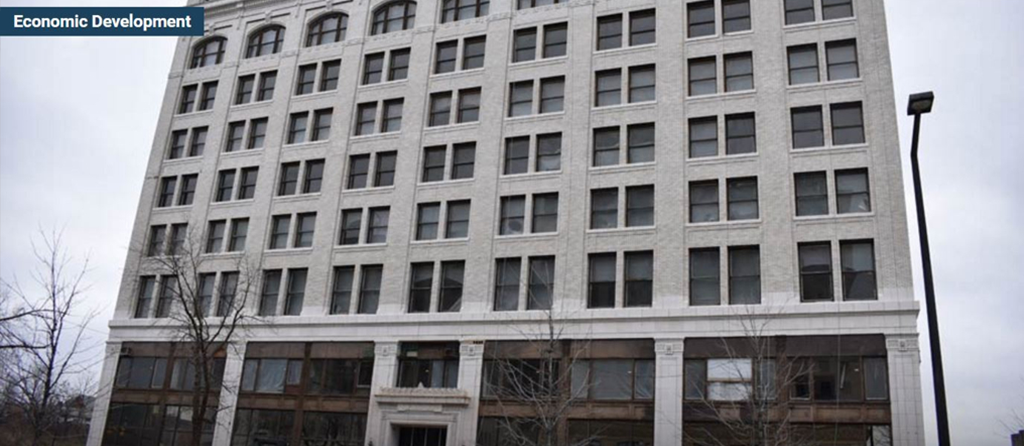Architect Provides Rotary with Stambaugh Project Update

YOUNGSTOWN, Ohio – Asked which floors the building trades are working on as renovation of the Stambaugh Building advances, architect Paul Hagman had a simple response Wednesday: Pretty much all of them.
Hagman is president of RBF CoLab.
Following several months of cleaning the downtown building of debris, workers in the building trades are busy on each floor of the 12-story former office property being converted into a DoubleTree by Hilton hotel. It’s slated to open late this year.
Construction phase began about two weeks ago, Hagman told the Rotary Club of Youngstown at its weekly meeting. It is on track to meet the December completion date, he said.
“To get to that date, we’re being careful with coordination to make sure the trades are coming in one right after the other,” he said. Crews began on the top floor and are working their way down, specific tasks performed on each level to prepare for subsequent phases, he said.
Hagman’s presentation focused on historic preservation, during which he discussed the $32.1 million Stambaugh project. He is a consulting architect on the project to ensure that the work adheres to standards to qualify for up to $9 million in federal and state historic preservation tax credits awarded the developer, NYO Property Group.
“Those tax credits allow developers to do these projects. They allow projects to also have things like shops in the bottom that enhance the local economy and add some interest,” he said.
Historic preservation “sometimes has a little bit of a stigma,” he acknowledged, because people think preservationists believe everything old must be valuable.
That isn’t the case, he said. Properties are valuable because their designs reflect the values of society at the time they were built.
“It reflects the big news of the day. It reflects the economy. It reflects the design in influences that are happening all around us,” he continued.
For instance, design elements of the First National Tower downtown reflect the interest in Egyptian motifs spurred by the 1922 discovery of King Tutankhamen’s tomb.
“That world news is now memorialized on one of the most beautiful buildings in downtown,” he said. “That’s what becomes so interesting to historic preservationists and why these buildings deserve to be respected. … They’re little time capsules of what’s going on.”
Older buildings tend to be better designed and built than those constructed more recently and using modern methods, he said.
In addition, reusing an already constructed building has greater sustainability value than building a new structure because a new building can’t be constructed using less energy than one already there, he posited. Only seven years after the Stambaugh Building was built in 1902, he noted, the owners decided they needed more space, and so added four floors.
“When it comes to sustainability, that’s incredibly green,” Hagman said.
Such restoration projects can be “phenomenally important to a community,” said Hunter Morrison, senior fellow in urban studies at Cleveland State University. On a practical level, historic properties provide access to the federal and state tax credits that provide incentives for private investment.
“We found, particularly in the Warehouse District in Cleveland, that we could basically access capital streams that otherwise would be unavailable to renovate these existing buildings,” he said.
Except for government or government-funded buildings such as the Covelli Centre and projects undertaken by nonprofits, all the commercial development in downtown Youngstown has been in historic buildings that used the tax credit incentives, said Bill Lawson, executive director of the Mahoning Valley Historical Society and Youngstown Rotary president.
Absent such incentives, such development might not take place. “We still don’t have a real estate market downtown that’s strong enough to support market-rate new development,” Lawson said.
The society undertook the renovation of the Harry Burt Building and converted it into the Tyler Mahoning Valley History Center.
“Historic districts like downtown Youngstown have their own unique character,” Lawson said. The city grew quickly in the late 19th and early 20th centuries and was defined by the architecture of the time. “It’s important to its future that you have that characteristic,” he said, “so part of what we’ve built in the past survives and keeps that personality and that look of downtown going.”
Such buildings are part of the fabric of a community, Morrison said. On many occasions — in Pittsburgh, Cleveland, and increasingly now in Youngstown and Warren – Morrison has seen the “psychic impact” of preservation efforts. “People feel good about it,” he said. “They feel that something of importance has been saved.
“As Paul said, they are often higher-quality buildings in terms of building materials than you can possibly afford,” he added. “So again, in the right hands, you get to enjoy that as an asset.”
Copyright 2017 The Business Journal, Youngstown, Ohio.
Source: http://businessjournaldaily.com/stambaugh-project-preserves-citys-character-architect-says/